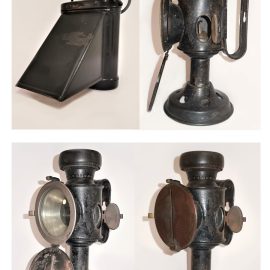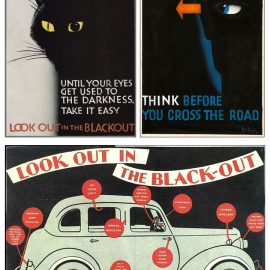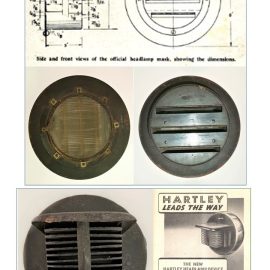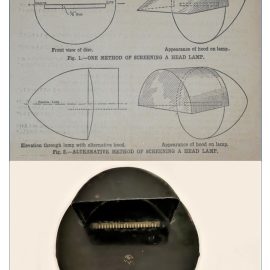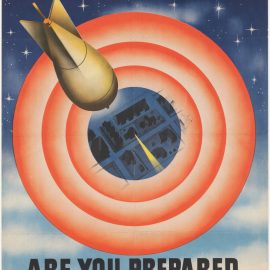
01 Aug Stories From the Stacks – Blackouts
A new series about the museum’s motoring memorabilia, compiled and written by FMM’s Assistant Curator Sian Theron. This month, Sian throws some light on blackouts…
Hello Darkness My Old Friend… Some of the lesser known items in the collection are our blackout lamps and lamp masks, of which we have a variety spanning both the Great War and the Second World War.
With the advent of the airplane (and Zeppelin airships in the 1st World War) came the threat of air raids. It was established early on that nicely lit up buildings made great targets at night. Lots of light, meant lots of people, lots of people, meant areas of importance, lots of importance, meant the perfect target.
Enter the blackout (and brownout) laws that stipulated that all lighting had to be strictly controlled. Street lights were switched off or reduced to only one light in 4, black out curtains were made mandatory. During the Second World War the blackout went into effect in Great Britain from 29 September 1939.
In Australia, as the threat was not as severe, the more relaxed light restrictions were referred to as brownouts. The blackout laws were taken very seriously and the public could find themselves in serious trouble if they so much as allowed a tiny beam of light to show.
To give you an idea of the seriousness of infractions during the blackout, there are records of people being arrested for lighting a match outside, in one instance an air raid warden took exception to a gentleman’s glowing cigar end, and he had to pay a stiff fine.
Of course with darkness comes a higher likelihood of accidents. The number of motor crashes rose exponentially with one accident per 200 vehicles on the road. Some commentators at the time scoffed that the blackout was doing the Luftwaffe’s (German Air force) work for them. Citizens were advised to make all journeys between 10 am and 4 pm to ensure that they travelled by daylight thus reducing the risk of night travel.
You can imagine how the rate of vehicle accidents increased drastically as both drivers and pedestrians could barely see. Even with additional safety precautions of wearing white arm bands, white painted running boards, and reduced speeds in the dark, the number of fatalities was extreme.
Nonetheless blackout precautions did most definitely reduce the effectivity of air raids, making targets that much more difficult to identify.
Throughout the war dimmed lighting – light masks and shields – were produced. These fitted over the car headlamps dramatically reducing the output of light but not entirely extinguishing it. Indicator lights had to be blacked out or disengaged, license plate illuminators were not permitted, and interior car lights were not permitted.
I have the great privilege to be looking after a few of these old war relics. It is quite something to imagine the impact of living in almost total darkness – although Load shedding does force us South Africans to unwillingly reminisce from time to time – at least we can drive with our lights on.
The thought of driving anywhere in total darkness with lights dimmed to not reach beyond a few meters ahead is very daunting. Add in the dread of knowing that whilst driving in near total darkness bombs may drop at any moment – it must have quite terrifying.
One of my favorite items is the candle lamp – this still has a partially burnt candle inside of it. There is a little door to the one side that opens for lighting the candle and the slatted mask can be kept open or closed. This type of lamp was more commonly used in the trenches.
The next are the blackout masks for car headlights – these are metal discs with a number of slats, which were fitted to lights and generally painted black. Although there was an official government design, over the course of the war a number of companies created their own versions. The museum has a few of these in the collection.
Lastly there were the bicycle lamps – these too had mask flaps that lowered down over the light beam, masking it and ensuring that all light was shone downwards. These little lamps were battery powered and fit onto bicycles. A very cool feature is a red screen that could be used to provide a further mask of the light.
The various light masks and lamps will be available for viewing in Hall A from the 1st August.




